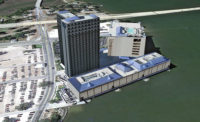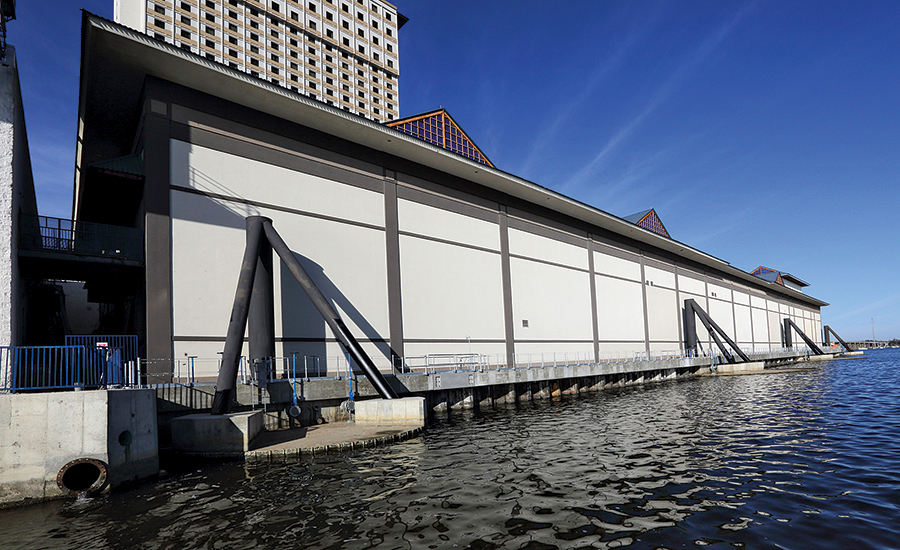Project of the Year & Best Renovation/Restoration: IP Casino Dry Dock

An aerial view of the finished Imperial Palace Casino Dry Dock.
PHOTO COURTESY OF GOOGLE EARTH

A photo taken after project completion of the Casino’s exterior and mooring.
PHOTO COURTESY OF JOHN THOMPSON PHOTOGRAPHY/YATES CONSTRUCTION

Barge hull final access and clearance for inspection and maintenance.
PHOTO COURTESY OF JOHN THOMPSON PHOTOGRAPHY/YATES CONSTRUCTION



ENR Texas & Louisiana’s judging panel was nearly unanimous in selecting the 2015 Project of the Year. Out of more than 100 entries, the Imperial Palace (IP) Casino Dry Dock emerged as the judges’ top pick.
“This project had an impressive safety record and project outcome,” one judge noted, “with unusual challenges that required innovative design and construction solutions—most of them underwater with zero visibility. All done without disrupting casino operations. I felt there was a ‘wow factor’ in reading about this.”
In the late 1990s, the IP Casino was built on the Back Bay in Biloxi, Miss. This permanently moored, floating casino, a three-floor vessel, sat upon nine hopper barges that were welded together. But after Hurricane Katrina struck in 2005, a state law was reversed that had previously required that all casinos float on water. As a result, IP Casino’s owner, Boyd Gaming Corp., sought design competition proposals to permanently dry dock its casino without interrupting its 24/7 operations.
In late 2010, Thompson Engineering won the contract, and contractor W.G. Yates & Sons Construction Co. began work on the dry, or graving, dock in 2011.
“The collaboration between Thompson, Yates and our company was nonstop,” says Ron Frye, vice president of design and construction at Boyd Gaming Corp. “We lived and breathed this project 24/7 for three years—with the best results we could have achieved.”
The IP Casino—without having been moved—is now a land-based vessel, providing a long-term extension to the life of the vessel, reducing maintenance costs and providing dry access to the vessel hull for easier repairs.
“Thompson efficiently incorporated much of our old infrastructure into the design,” Frye adds.
Design and construction of the dry dock also needed to accommodate extraordinarily variable soil conditions where the graving dock would stand.
“Our dry dock design employed a first-of-its-kind solution that produced a long-term, stabilized foundation to support the 32-million-pound IP Casino vessel and surrounding facilities,” says Henry Seawell, principal engineer at Thompson Engineering.
That system also needed to ensure no long-term settlement beneath the graving dock, despite the highly compressible subsoils and huge structural loads. Original concepts anticipated up to 24 in. of differential settlement once the vessel was dry-docked atop the 8-ft-thick, concrete-coffer-seal slab.
“When Mr. Seawell told us about the plan, we were, quite frankly, a bit skeptical,” says Ray Winters, construction project manager with Yates. “Nevertheless, Thompson’s design incorporated intricate and well-conceived solutions that we could understand and build—even in the most challenging working conditions our marine construction group has ever faced.”
Divers dredged the area under and around the existing casino vessel to precise subaqueous neat line profiles in zero-visibility conditions to remove 33,300 cu yd of silt, clay and sand. Then, the area around the vessel was enclosed with 820 linear ft of a cantilevered combination pipe pile/sheet pile cofferdam.
Because no direct access was available when placing the 2,000 tons of reinforcement required for the massive seal slab, the team created a series of floating pontoon sections. The contractor floated in 40-ft by 125-ft steel pontoon reinforcement sections and ballasted them into place along a guide rail system. It was integrated into the initial stabilization mat placed on soft subaqueous soils beneath the vessel. After it was positioned by divers, the reinforcing pontoon frames were bolted together and shimmed to design elevation using remote pneumatic leveling controls, just before placement of the surrounding 18,000 cu yd of underwater seal slab concrete.
In complete darkness, using remote radio control, divers and supporting topside crews built a 615-ft-long by 130-ft-wide graving dock structure made of a structural-steel-blocking frame, encompassed by a concrete mat foundation, which was the world’s largest continuous underwater concrete pour when performed.
All below-sea-level construction before unwatering of the coffer basin was done in zero-visibility conditions.
The concrete and integral studded walls were allowed to move independently of the surrounding coffer cell sheet pile system during the preconsolidation phase. Ground waters below the slab were depressed through a system of peripheral shallow and deep wells, and an induced load of a non-buoyant soil mass presettled and precompressed the subsoils sufficiently to prevent future movement.
Since completion in December 2014, the graving dock slab, with 150 million lb of vessel and concrete atop it, has experienced no measurable settlement.
“There were so many unknowns,” Seawell says. “We relied on our many years of experience in construction projects in difficult coastal marine environments. Above all, work was completed safely.”
Yates’ safety program was built around behavior-based safety and an onsite process called safety task assessment (STA). On the jobsite, the “Brother’s Keeper” program asked employees to sign a pledge to watch out for each other as well. Thompson was also on site to provide safety oversight. This resulted in 230,000 man-hours worked with no safety incidents.
“Safety was our constant and upmost concern, and we achieved the goals our company, our client and Thompson set for the project at the outset,” Winters adds.
Each portion of the project was carefully planned out, and the team reached a consensus on methods and quality controls for every phase.
“And in three years of construction, the commercial operations of the resort were never closed because of the project—not once,” Seawell says.
Despite several tropical storms hitting the area during construction, plus facing a myriad of unknown conditions, the project was completed on budget with no net-of-base-contract-value change orders.
“There was constant communication between Yates, Thompson and Boyd Gaming Corp. This project was successful not only because of the initial design, but also because of the teamwork that was demonstrated on a daily basis,” Winters adds.
In the end, the project cost came out to less than one-third what the price would have been to build a new facility on land.
IP Casino Dry Dock
Biloxi, Miss.
Key Players
Owner Boyd Gaming Corp.
Lead Design Firm/Structural/Civil Thompson Engineering
General Contractor W.G. Yates & Sons Construction Co.
MEP Engineer BayFour Design LLC







